Fault Reactivation Can Generate Hydraulic Short Circuits in Underground Coal Gasification—New Insights from Regional-Scale Thermo-Mechanical 3D Modeling
Abstract
:1. Introduction
2. Materials and Methods
2.1. Numerical Model Geometry, Parametrization and Boundary Conditions
2.2. Scenario Analysis and UCG Panel Design
3. Simulation Results
3.1. Vertical Temperature Distribution in the UCG Channel Vicinity
3.1.1. Permeability Distribution in the Rocks Surrounding the UCG Channels
3.1.2. Vertical Displacements at 2000 Days (End of Operation)
3.1.3. Stress States at Fault Elements
3.1.4. Fault Integrity
3.2. Influence of Pillar Width on Fault Stability
3.3. Influence of Stress Regime on Fault Stability
4. Discussion
5. Summary and Conclusions
Acknowledgments
Author Contributions
Conflicts of Interest
References
- Blinderman, M.S.; Saulov, D.N.; Klimenko, A.Y. Forward and reverse combustion linking in underground coal gasification. Energy 2008, 33, 446–454. [Google Scholar] [CrossRef]
- Nakaten, N.; Kötting, P.; Azzam, R.; Kempka, T. Underground coal gasification and CO2 storage support Bulgaria’s low carbon energy supply. Energy Procedia 2013, 40, 212–221. [Google Scholar] [CrossRef]
- Burton, E.; Friedmann, J.; Upadhye, R. Best Practices in Underground Coal Gasification; Contract No. W-7405-Eng-48; Lawrence Livermore National Laboratory: Livermore, CA, USA, 2006.
- Friedmann, S.J.; Upadhye, R.; Kong, F.M. Prospects for underground coal gasification in carbon-constrained world. Energy Procedia 2009, 1, 4551–4557. [Google Scholar] [CrossRef]
- Kempka, T.; Plötz, M.L.; Schlüter, R.; Hamann, J.; Deowan, S.A.; Azzam, R. Carbon dioxide utilisation for carbamide production by application of the coupled UCG-urea process. Energy Procedia 2011, 4, 2200–2205. [Google Scholar] [CrossRef]
- Bhutto, A.W.; Bazmi, A.A.; Zahedi, G. Underground coal gasification: From fundamentals to applications. Prog. Energy Combust. Sci. 2013, 39, 189–214. [Google Scholar] [CrossRef]
- Yang, D.; Koukouzas, N.; Green, M.; Sheng, Y. Recent development on underground coal gasification and subsequent CO2 storage. J. Energy Inst. 2015. [Google Scholar] [CrossRef]
- Klebingat, S.; Kempka, T.; Schulten, M.; Azzam, R.; Fernandez-Steeger, T.M. Innovative thermodynamic underground coal gasification model for coupled synthesis gas quality and tar production analyses. Fuel 2016, 183, 680–686. [Google Scholar] [CrossRef]
- Sury, M.; White, M.; Kirton, J.; Carr, P.; Woodbridge, R. Review of Environmental Issues of Underground Coal Gasification; University of Liège Belgium: Liège, Belgium, 2004. [Google Scholar]
- Sirdesai, N.; Singh, R.; Sing, T.N.; Ranjith, P.G. Numerical and experimental study of strata behavior and land subsidence in an underground coal gasification project. Int. Assoc. Hydrol. Sci. 2015, 372. [Google Scholar] [CrossRef]
- Couch, G. Underground Coal Gasification; CCC/151; IEA Clean Coal Centre: London, UK, 2009. [Google Scholar]
- Najafi, M.; Jalali, S.M.E.; KhaloKakaie, R.; Forouhandeh, F. Prediction of cavity growth rate during underground coal gasification using multiple regression analysis. Int. J. Coal Sci. Technol. 2015, 2, 318–324. [Google Scholar] [CrossRef]
- Tian, H.; Kempka, T.; Yu, S.; Ziegler, M. Mechanical properties of sandstones exposed to high temperature. Rock Mech. Rock Eng. 2016, 49, 321–327. [Google Scholar] [CrossRef]
- Tian, H.; Ziegler, M.; Kempka, T. Physical and mechanical behavior of claystone exposed to temperatures up to 1000 °C. Int. J. Rock Mech. Min. Sci. 2014, 70, 144–153. [Google Scholar] [CrossRef]
- Tian, H.; Kempka, T.; Xu, N.X.; Ziegler, M. Physical properties of sandstones after high temperature treatment. Rock Mech. Rock Eng. 2012, 45, 1113–1117. [Google Scholar] [CrossRef]
- Tian, H.; Kempka, T.; Xu, N.; Ziegler, M. A modified Mohr-Coulomb failure criterion for intact granites exposed to high temperatures. In Clean Energy Systems in the Subsurface: Production, Storage and Conversion; Hou, M.Z., Xie, H., Were, P., Eds.; Springer Series in Geomechanics and Geoengineering; Springer: Berlin, Germany, 2013; pp. 379–393. [Google Scholar]
- Tian, H.; Ziegler, M.; Kempka, T. Mechanical behavior of claystone exposed to high temperatures and its possible impacts on the stability of a deep nuclear waste repository. In Rock Mechanics: Achievements and Ambitions; Cai, M., Ed.; Taylor & Francis Group: London, UK, 2012; pp. 193–199. [Google Scholar]
- Tian, H. Development of a Thermo-Mechanical Model for Rocks Exposed to High Temperatures during Underground Coal Gasification; No. RWTH-CONV-143478; RWTH Aachen University: Aachen, Germany, 2013. [Google Scholar]
- Wolf, K.H.; Bruining, H. Modelling the interaction between underground coal fires and their roof rocks. Fuel 2007, 86, 2761–2777. [Google Scholar] [CrossRef]
- Hettema, M.H.H.; Wolf, K.H.A.A.; de Pater, C.J. The influence of steam pressure on thermal spalling of sedimentary rock: Theory and experiments. Int. J. Rock Mech. Min. Sci. 1998, 35, 3–15. [Google Scholar] [CrossRef]
- Kapusta, K.; Stańczyk, K. Pollution of water during underground coal gasification of hard coal and lignite. Fuel 2011, 90, 1927–1934. [Google Scholar] [CrossRef]
- Stańczyk, K.; Smoliński, A.; Kapusta, K.; Wiatowski, M.; Świdrowski, J.; Kotyrba, A.; Rogut, J. Dynamic experimental simulation of hydrogen oriented underground gasification of lignite. Fuel 2010, 89, 3307–3314. [Google Scholar] [CrossRef]
- Stańczyk, K.; Howaniec, N.; Smoliński, A.; Świądrowski, J.; Kapusta, K.; Wiatowski, M.; Grabowski, J.; Rogut, J. Gasification of lignite and hard coal with air and oxygen enriched air in a pilot scale ex situ reactor for underground gasification. Fuel 2011, 90, 1953–1962. [Google Scholar] [CrossRef]
- Durucan, S.; Korre, A.; Shi, J.Q.; Idiens, M.; Stańczyk, K.; Kapusta, K.; Rogut-Dabrowska, A.; Kempka, T.; Wolf, K.H.; Younger, P.; et al. TOPS: Technology options for coupled underground coal gasification and CO2 capture and storage. Energy Procedia 2014, 63, 5827–5835. [Google Scholar] [CrossRef]
- Klimenko, A.Y. Early ideas in underground coal gasification and their evolution. Energies 2009, 2, 456–476. [Google Scholar] [CrossRef]
- Sajjad, M.; Rasul, M.G. Review on the Existing and Developing Underground Coal Gasification Techniques in Abandoned Coal Seam Gas Blocks: Australia and Global Context. In Proceedings of the 1st International e-Conference on Energies, Online, Switzerland, 14–31 March 2014.
- Khan, M.; Mmbaga, J.; Shirazi, A.; Trivedi, J.; Liu, Q.; Gupta, R. Modelling Underground Coal Gasification—A Review. Energies 2015, 8, 12603–12668. [Google Scholar] [CrossRef]
- Nitao, J.J.; Camp, D.W.; Buscheck, T.A.; White, J.A.; Burton, G.C.; Wagoner, J.L.; Chen, M. Progress on a new integrated 3-D UCG simulator and its initial application. In Proceedings of the International Pittsburgh Coal Conference (PCC), Pittsburgh, PA, USA, 12–15 September 2011.
- Nourozieh, H.; Kariznovi, M.; Chen, Z.; Abedi, J. Simulation Study of Underground Coal Gasification in Alberta Reservoirs: Geological Structure and Process Modeling. Energy Fuels 2010, 24, 3540–3550. [Google Scholar] [CrossRef]
- Adhikary, D.; Khanal, M.; Jayasundara, C.; Balusu, R. Deficiencies in 2D Simulation: A Comparative Study of 2D Versus 3D Simulation of Multi-seam Longwall Mining. Rock Mech. Rock Eng. 2016, 49, 2181–2185. [Google Scholar] [CrossRef]
- Otto, C.; Kempka, T. Thermo-Mechanical Simulations of Rock Behavior in Underground Coal Gasification Show Negligible Impact of Temperature-Dependent Parameters on Permeability Changes. Energies 2015, 8, 5800–5827. [Google Scholar] [CrossRef]
- Otto, C.; Kempka, T. Thermo-mechanical Simulations Confirm: Temperature-dependent Mudrock Properties are Nice to have in Far-field Environmental Assessments of Underground Coal Gasification. Energy Procedia 2015, 76, 582–591. [Google Scholar] [CrossRef]
- Itasca Consulting Group Inc. Advanced Three-Dimensional Continuum Modelling for Geotechnical Analysis of Rock, Soil and Structural Support. In FLAC3D Software Version 5.01. User’s Manual; Itasca Consulting Group, Inc.: Minneapolis, MN, USA, 2014. [Google Scholar]
- Chećko, J. Analysis of geological, hydrogeological and mining conditions in the area of the developed georeactor located in KWK ‘Wieczorek’ mine. Prz. Górn. 2013, 69, 37–45. [Google Scholar]
- Jarosinski, M. Recent tectonic stress field investigations in Poland: A state of the art. Geol. Q. 2006, 50, 303–321. [Google Scholar]
- Sarhosis, V.; Yang, D.; Sheng, Y.; Kempka, T. Coupled Hydro-thermal Analysis of Underground Coal Gasification Reactor Cool Down for Subsequent CO2 Storage. Energy Procedia 2013, 40, 428–436. [Google Scholar] [CrossRef]
- Byerlee, J. Friction of Rocks. Pure Appl. Geophys. 1978, 116, 615–626. [Google Scholar] [CrossRef]
- Somerton, W.H. Thermal Properties and Teemperature-Related Behavior of Rock/Fluid Systems; Chilingarian, G.V., Ed.; Elsevier Science Publishers H.V.: Amsterdam, The Netherlands, 1992; Volume 53. [Google Scholar]
- Speight, J.G. Handbook on Coal Analysis; Winefordner, J.D., Ed.; Wiley: Hoboken, NJ, USA, 2005. [Google Scholar]
- Tan, Q.; Luo, X.; Li, S. Numerical modeling of thermal stress in a layered rock mass. In Proceedings of the the 42nd U.S. Rock Mechanics Symposium (USRMS), San Francisco, CA, USA, 29 June–2 July 2008.
- Małkowski, P.; Niedbalski, Z.; Hydzik-Wiśniewska, J. The Change of Structural and Thermal Properties of Rocks Exposed to High Temperatures in the Vicinity of Designed Geo-Reactor. Arch. Min. Sci. 2013, 58, 465–480. [Google Scholar]
- Cała, M.; Stopkowicz, A.; Kowalska, M.; Blajer, M. Modelling of thermal phenomena in the rock mass in the vicinity of a georeactor. Prz. Górn. 2014, 11, 76–85. [Google Scholar]
- Blinderman, M.S.; Ergo Exergy Technologies Inc., Montreal, QC, Canada. Personal communication, 2016.
- Ligtenberg, J.H. Detection of Fluid migration pathways in seismic data: Implications for fault seal analysis. Basin Res. 2005, 17, 141–153. [Google Scholar] [CrossRef]
- Price, N.J.; Cosgrove, J.W. Analysis of Geological Structures; Cambridge University Press: Cambridge, UK, 1990. [Google Scholar]
- Van der Zee, W. Dynamics of Fault Gouge Development in Layered Sand Clay Sequences. Ph.D. Thesis, RWTH Aachen University, Aachen, Germany, 2002. [Google Scholar]
- Koledoye, B.A.; Aydin, A.; May, E. A new process-based methodology for the analysis of shale smear along normal faults in the Niger Delta. Am. Assoc. Pet. Geol. Bull. 2003, 87, 445–463. [Google Scholar] [CrossRef]
- Liu, X.; Zhang, C.; Yuan, S.; Fityus, S.; Sloan, S.W.; Buzzi, O. Effect of High Temperature on Mineralogy, Microstructure, Shear Stiffness and Tensile Strength of Two Australian Mudstones. Rock Mech. Rock Eng. 2016, 49, 3513–3524. [Google Scholar] [CrossRef]
- Hettema, M.H.H.; Wolf, K.A.A.; de Pater, C.J. Thermo-mechanical properties of roof rock of coal for underground gasification. In Topics in Applied Mechanics; Springer: Berlin, Germany, 1993. [Google Scholar]
- Chin, L.Y.; Rajagopal, R.; Thomas, L.K. Fully Coupled Geomechanics and Fluid-Flow Analysis of Wells With Stress-Dependent Permeability. SPE J. 2000, 5, 2–6. [Google Scholar] [CrossRef]
- Min, O.K. Finite Element Modeling of Thermo-Mechanical Responses Associated with Underground Coal Conversion; Ohio State University: Columbus, OH, USA, 1983. [Google Scholar]
- Jarosinski, M. Ongoing tectonic reactivation of the Outer Carpathians and its impact on the foreland: Results of borehole breakout measurements in Poland. Tectonophysics 2005, 410, 189–216. [Google Scholar] [CrossRef]
- Jarosinski, M. Recent tectonic stress regime in Poland based on analyses of hydraulic fracturing of borehole walls. Prz. Geol. 2005, 53, 863–872. [Google Scholar]
- Liu, X.; Yuan, S.; Sieffert, Y.; Fityus, S.; Buzzi, O. Changes in Mineralogy, Microstructure, Compressive Strength and Intrinsic Permeability of Two Sedimentary Rocks Subjected to High-Temperature Heating. Rock Mech. Rock Eng. 2016, 49, 2985–2998. [Google Scholar] [CrossRef]
- Min, K.B.; Rutqvist, J.; Tsang, C.F.; Jing, L. Thermally induced mechanical and permeability changes around a nuclear waste repository—A far-field study based on equivalent properties determined by a discrete approach. Int. J. Rock Mech. Min. Sci. 2005, 42, 765–780. [Google Scholar] [CrossRef]
- David, C.; Menendez, B.; Darot, M. Influence of stress-induced and thermal cracking on physical properties and microstructure of La Peyratte granite. Int. J. Rock Mech. Min. Sci. 1999, 36, 433–448. [Google Scholar] [CrossRef]
- Luo, Y.; Coertzen, M.; Dumble, S. Comparison of UCG Cavity Growth With CFD Model Predictions. In Proceedings of the Seventh International Conference on CFD in the Minerals and Process Industries (CSIRO), Melbourne, Australia, 9–11 December 2009; pp. 1–5.
- Li, H.; Guo, G.; Zha, J.; Yuan, Y.; Zhao, B. Research on the surface movement rules and prediction method of underground coal gasification. Bull. Eng. Geol. Environ. 2016, 75, 1133–1142. [Google Scholar] [CrossRef]
- Evans, B.W.; Kohlstedt, D.L. Rheology of rocks. In Rock Physics & Phase Relations: A Handbook of Physical Constants; American Geophysical Union: Washington, DC, USA, 1995; Volume 3, pp. 148–165. [Google Scholar]
- Blinderman, M.S.; Anderson, B. Underground Coal Gasification for Power Generation: High Efficiency and CO2-Emissions. In Proceedings of the ASME 2004 Power Conference, Baltimore, MD, USA, 31 March–1 April 2004; pp. 473–479.
- Blinderman, M.S.; Jones, R.M. The Chinchilla IGCC Project to Date: Underground Coal Gasification and Environment. In Proceedings of the Gasification Technologies Conference, San Francisco, CA, USA, 27–30 October 2002.
- Plumb, O.A.; Klimenko, A. The stability of evaporating fronts in porous media. J. Porous Media 2010, 13, 145–155. [Google Scholar] [CrossRef]
- Najafi, M.; Jalali, S.M.E.; KhaloKakaie, R. Thermal–mechanical–numerical analysis of stress distribution in the vicinity of underground coal gasification (UCG) panels. Int. J. Coal Geol. 2014, 134–135, 1–16. [Google Scholar] [CrossRef]
- Sen, A.T.; Cesca, S.; Bischoff, M.; Meier, T.; Dahm, T. Automated full moment tensor inversion of coal mining-induced seismicity. Geophys. J. Int. 2013, 195, 1267–1281. [Google Scholar] [CrossRef]
- Hasegawa, H.S.; Wetmiller, R.J.; Gendzwill, D.J. Induced seismicity in mines in Canada—An overview. Pure Appl. Geophys. 1989, 129, 423–453. [Google Scholar] [CrossRef]
- Vorobiev, O.; Morris, J.; Antoun, T.; Friedmann, S.J. Geomechanical Simulations Related to UCG Activities. In Proceedings of the International Pittsburgh Coal Conference, Pittsburgh, PA, USA, 29 September–2 October 2008.
- Rutqvist, J.; Rinaldi, A.P.; Cappa, F.; Moridis, G.J. Modeling of fault reactivation and induced seismicity during hydraulic fracturing of shale-gas reservoirs. J. Pet. Sci. Eng. 2013, 107, 31–44. [Google Scholar] [CrossRef]
- Tillner, E.; Langer, M.; Kempka, T.; Kühn, M. Fault damage zone volume and initial salinity distribution determine intensity of shallow aquifer salinisation in subsurface storage. Hydrol. Earth Syst. Sci. 2016, 20, 1049–1067. [Google Scholar] [CrossRef]
- Cappa, F.; Rutqvist, J. Modeling of coupled deformation and permeability evolution during fault reactivation induced by deep underground injection of CO2. Int. J. Greenh. Gas Control 2011, 5, 336–346. [Google Scholar] [CrossRef]
- Jacquey, A.B.; Cacace, M.; Blöcher, G.; Scheck-Wenderoth, M. Numerical Investigation of Thermoelastic Effects on Fault Slip Tendency during Injection and Production of Geothermal Fluids. Energy Procedia 2015, 76, 311–320. [Google Scholar] [CrossRef]
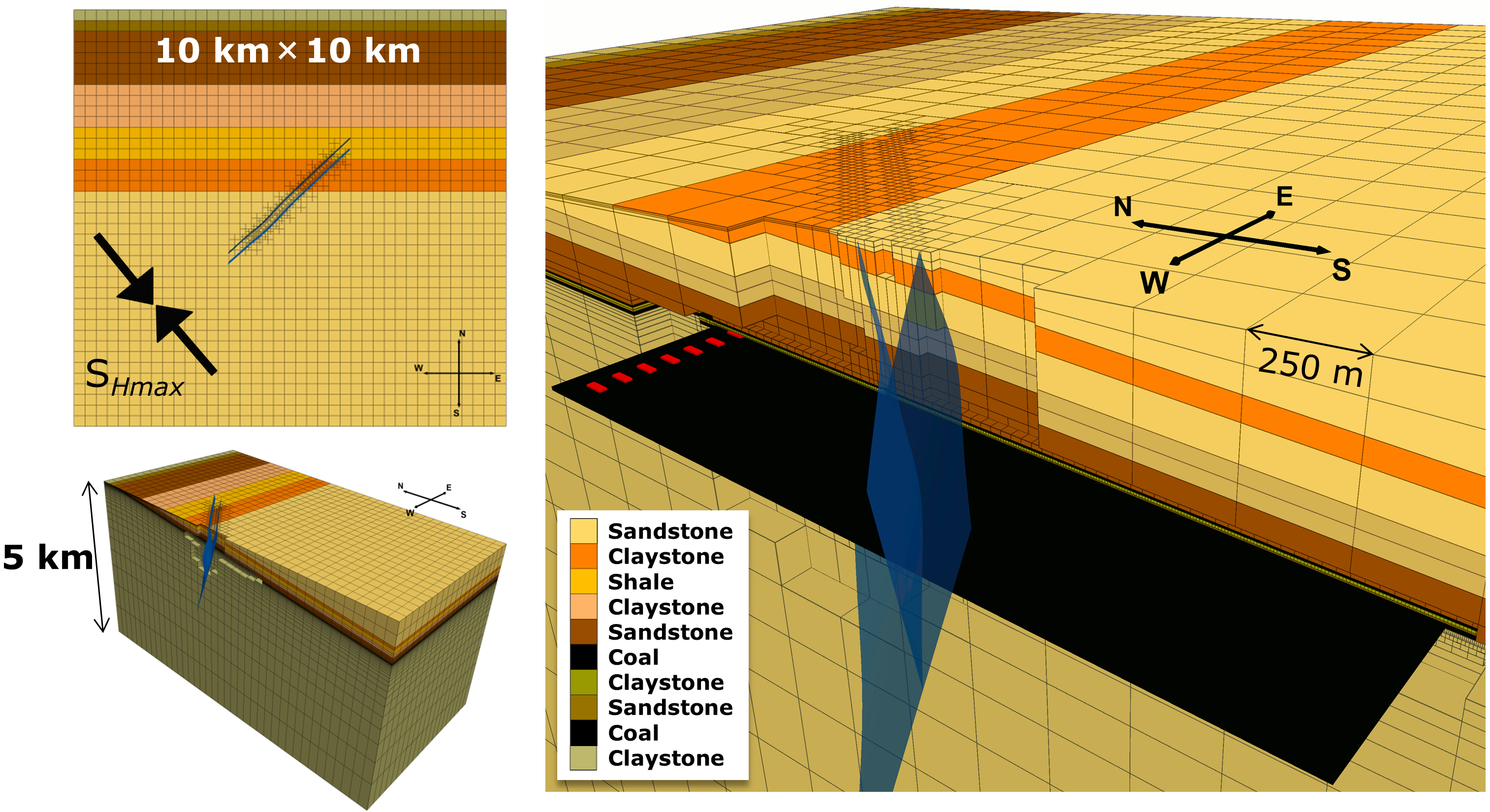
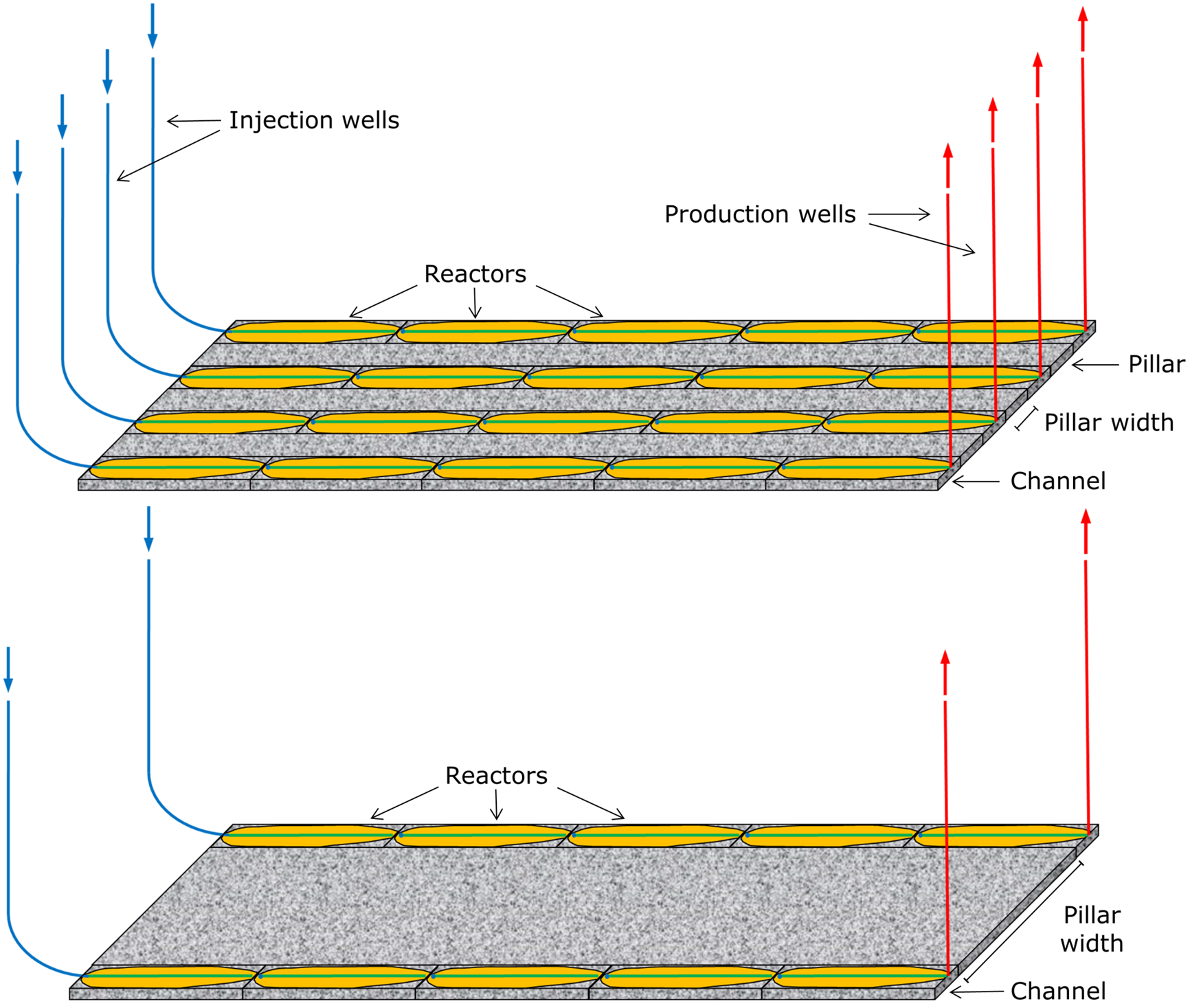
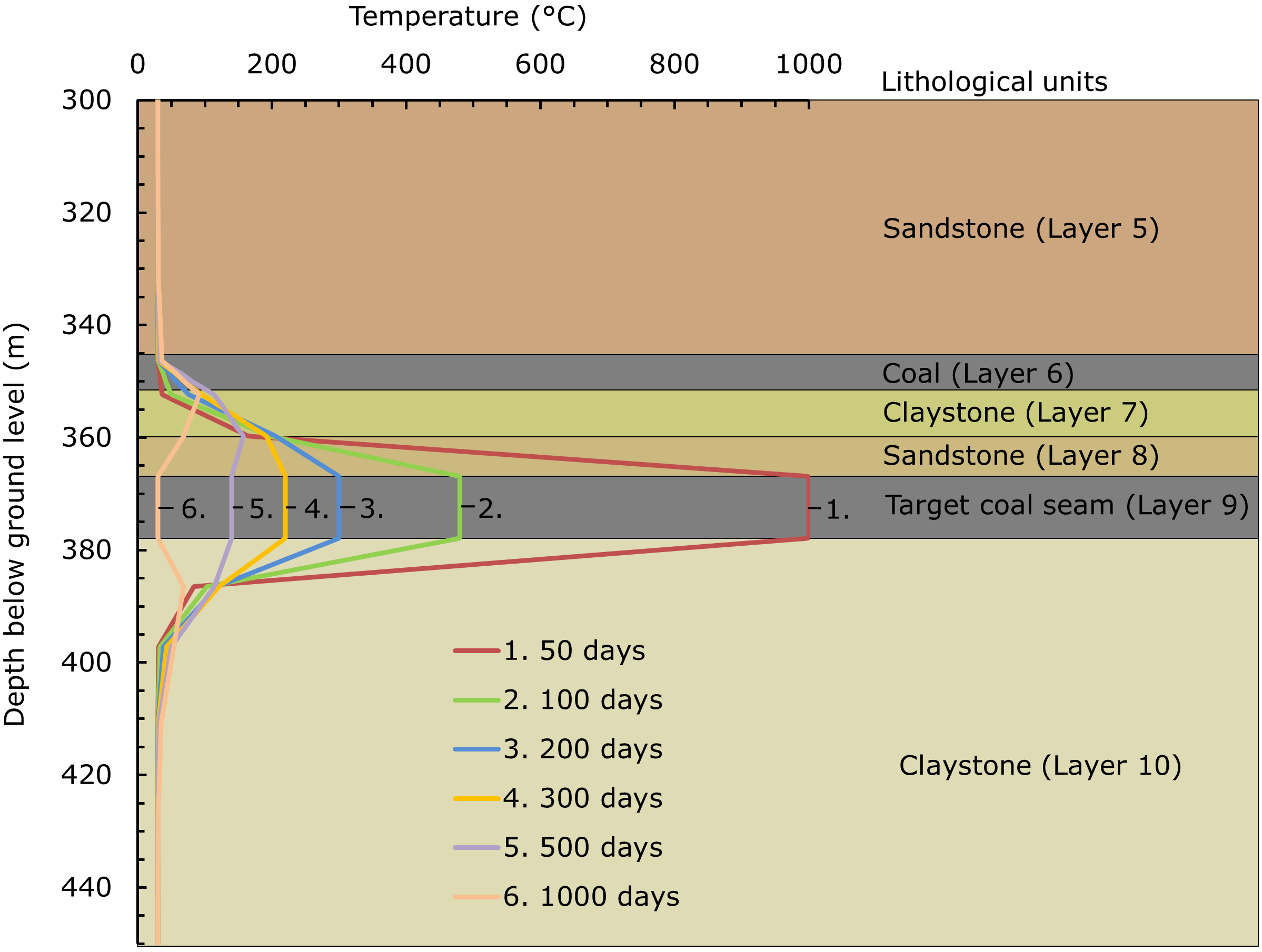
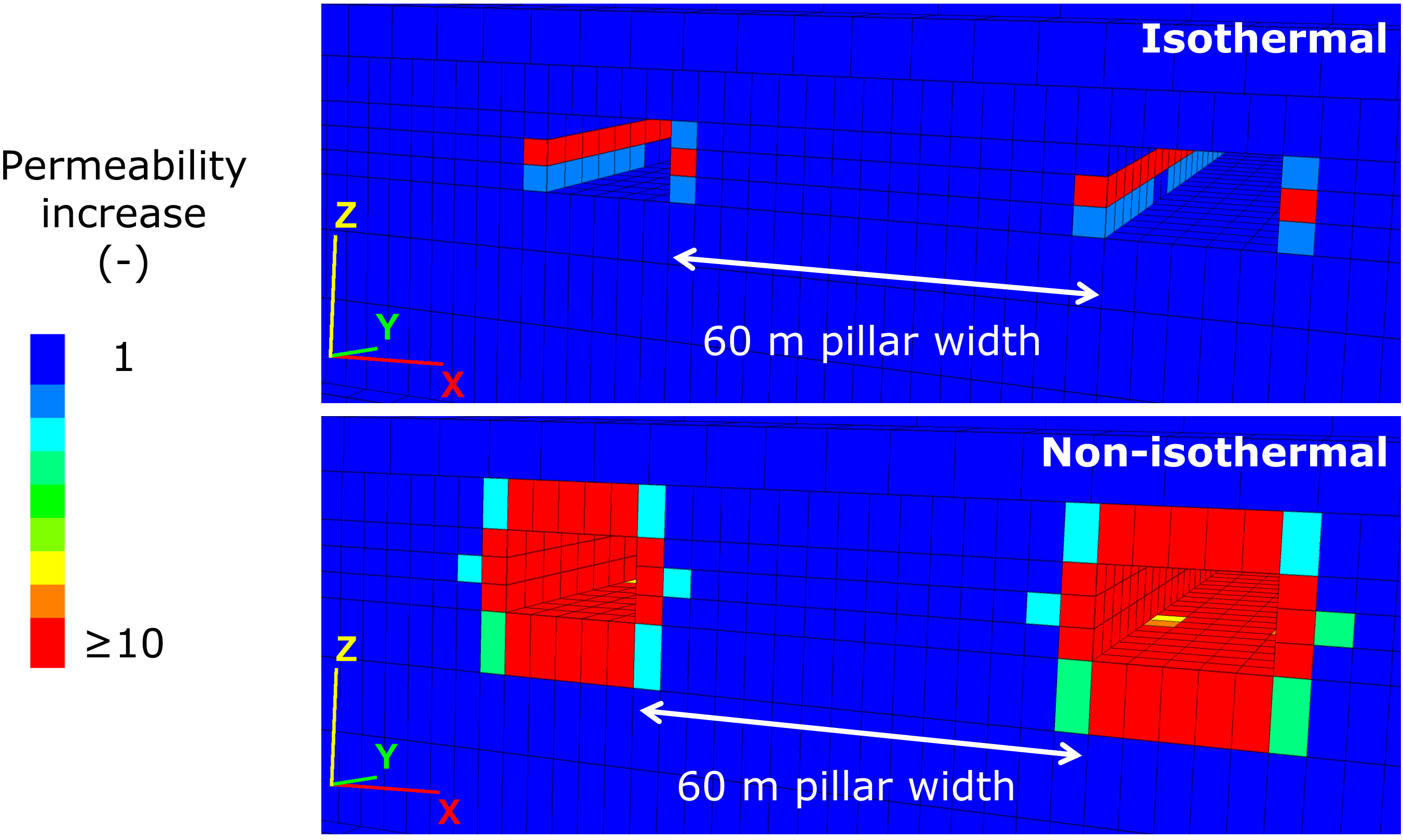
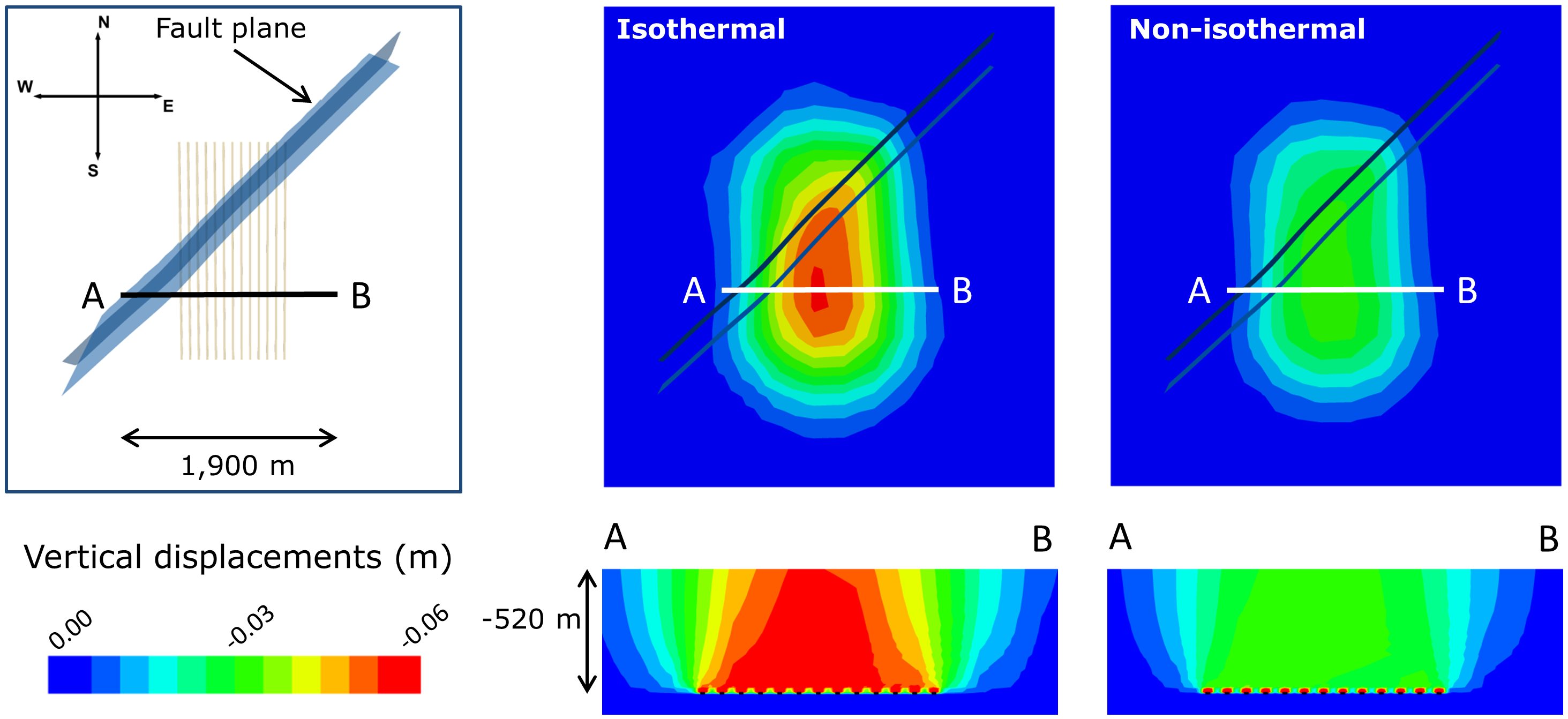
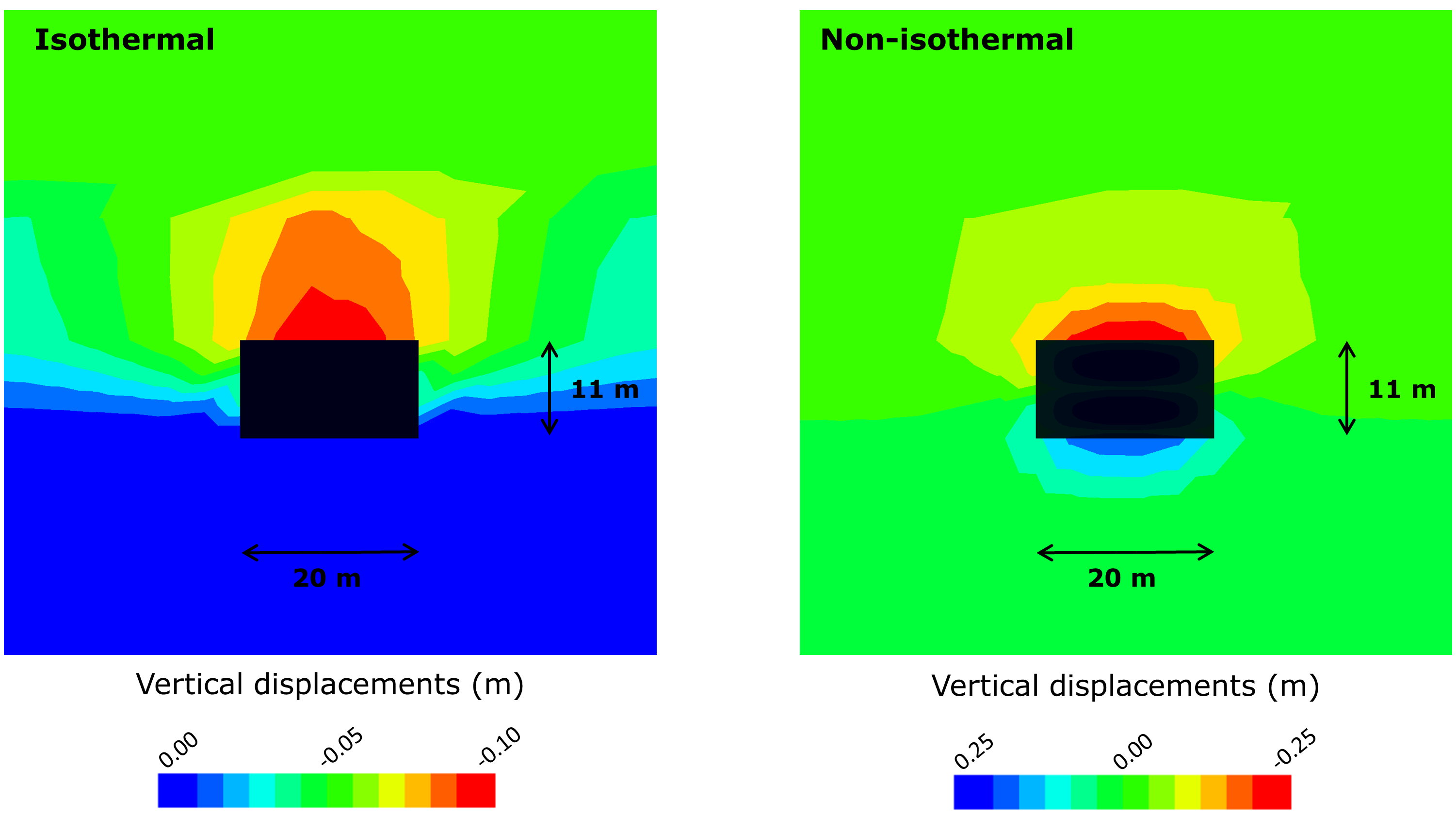


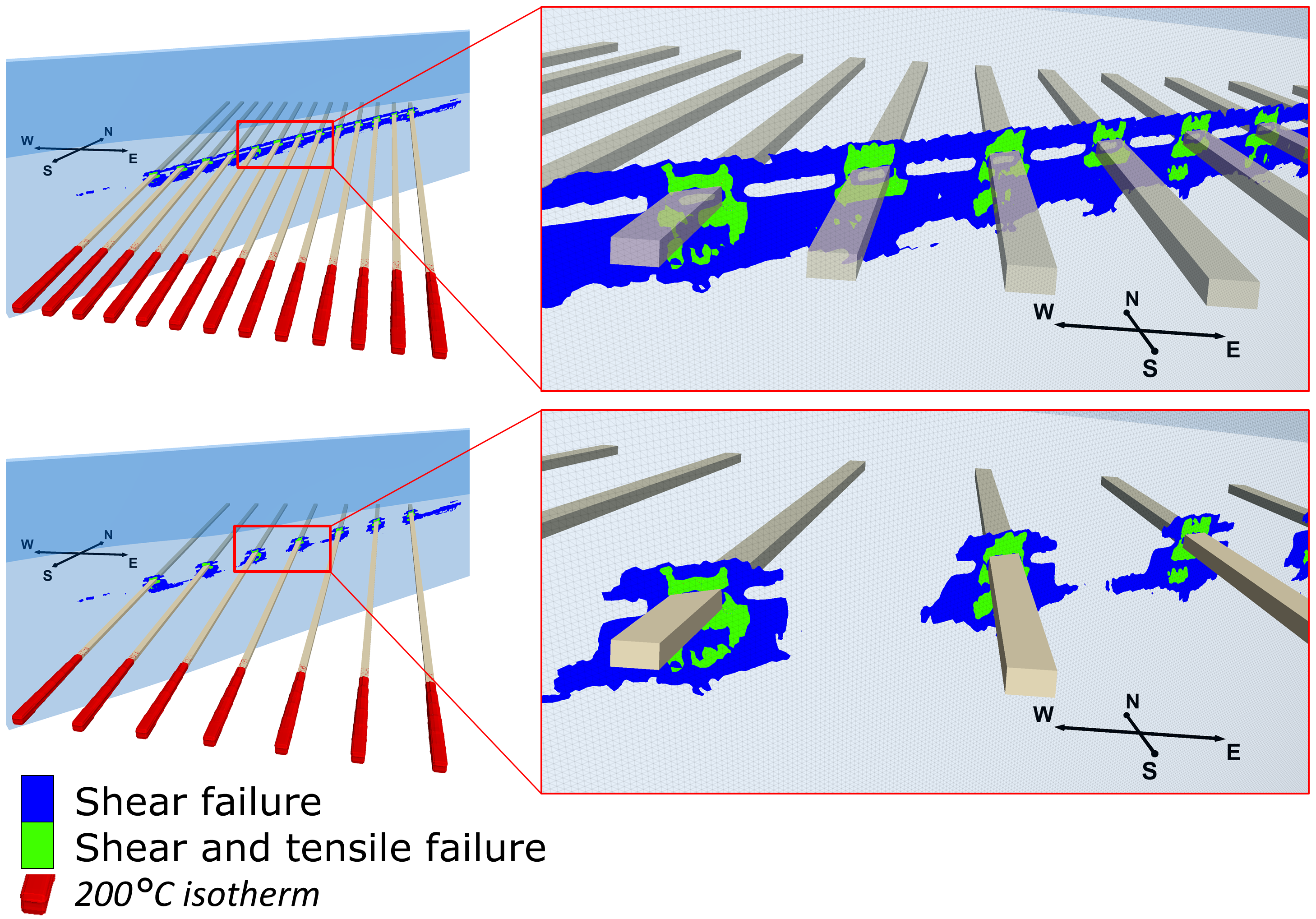
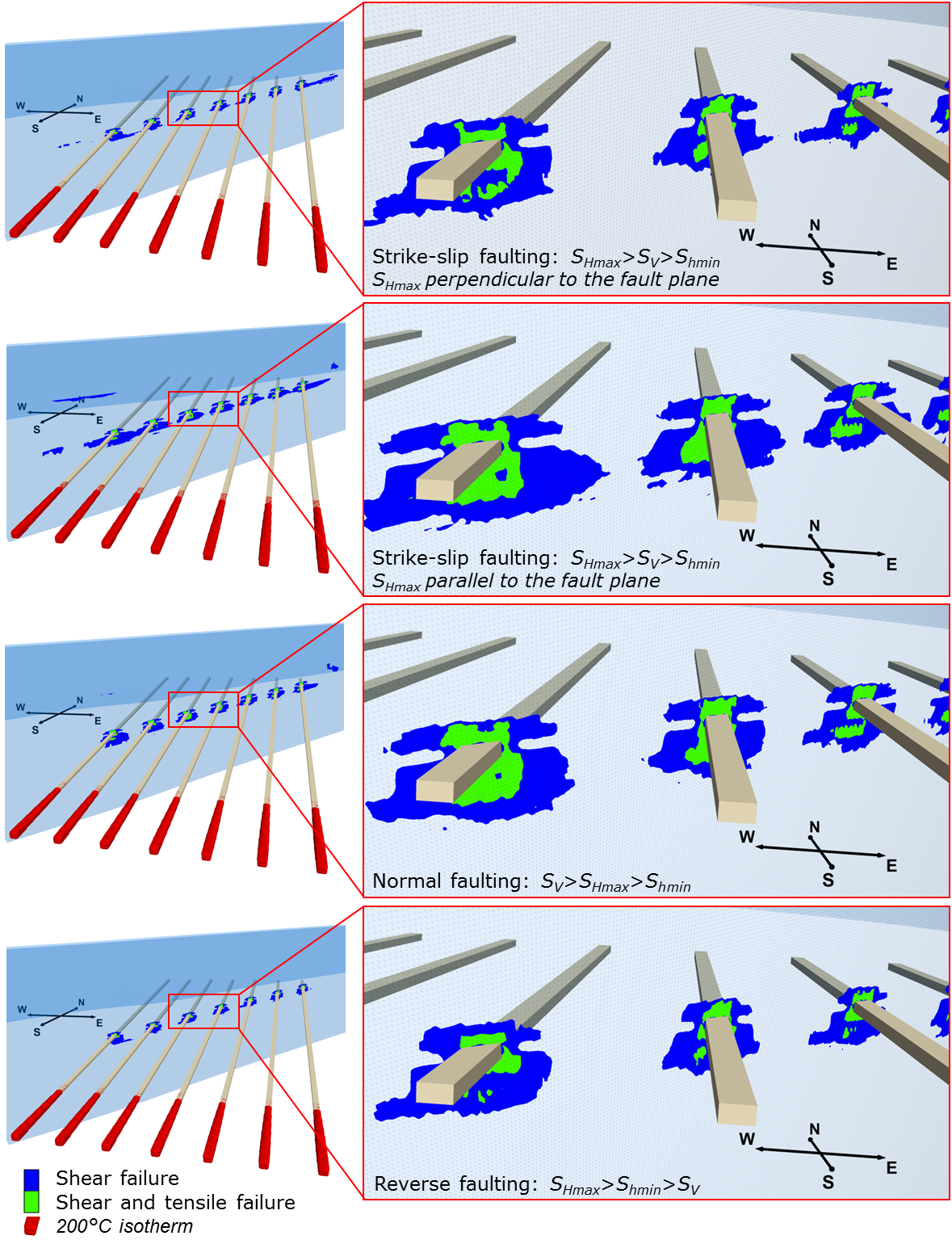
| Lithological Units | Young’s Modulus (GPa) | Tensile Strength (MPa) | Friction Angle 1 (°) | Cohesion 2 (MPa) | Poisson’s Ratio (-) | Density (kg·m−3) | Dilation Angle (°) |
|---|---|---|---|---|---|---|---|
| Sandstone (Layer 1) | 7.5 | 2.0 | 31 | 14.9 | 0.21 | 2115 | - |
| Claystone (Layer 2) | 8.2 | 2.7 | 31 | 19.0 | 0.27 | 2458 | - |
| Shale (Layer 3) | 8.2 | 2.3 | 31 | 17.2 | 0.25 | 2399 | - |
| Claystone (Layer 4) | 7.8 | 2.6 | 31 | 18.2 | 0.27 | 2397 | - |
| Sandstone (Layer 5) | 8.8 | 2.0 | 31 | 15.9 | 0.21 | 2407 | - |
| Coal (Layer 6) | 0.7 | 0.6 | 31 | 3.8 | 0.35 | 1281 | - |
| Claystone (Layer 7) | 8.0 | 3.8 | 31 | 10.9 | 0.27 | 2465 | - |
| Sandstone (Layer 8) | 8.5 | 1.9 | 31 | 15.3 | 0.21 | 2262 | - |
| Target coal seam (Layer 9) | 0.7 | 0.6 | 31 | 3.8 | 0.35 | 1281 | - |
| Claystone (Layer 10) | 80 | 3.8 | 31 | 10.9 | 0.27 | 2465 | - |
| Fault | - | - | 20 | 0 | - | - | 10 |
| Lithological Units | Linear Thermal Expansion Coefficient (K−1) | Specific Heat Capacity (J·kg−1·K−1) | Thermal Conductivity (W·m−1·K−1) |
|---|---|---|---|
| Sandstone (Layer 5) | 1.6 × 10−5 | 1210 | 4.67 |
| Coal (Layer 6) | 3.3 × 10−5 | 1130 | 0.5 |
| Claystone (Layer 7) | 7.9 × 10−5 | 970 | 2.57 |
| Sandstone (Layer 8) | 1.6 × 10−5 | 1210 | 4.67 |
| Target coal seam (Layer 9) | 3.3 × 10−5 | 1130 | 0.5 |
| Claystone (Layer 10) | 7.9 × 10−5 | 970 | 2.57 |
© 2016 by the authors; licensee MDPI, Basel, Switzerland. This article is an open access article distributed under the terms and conditions of the Creative Commons Attribution (CC-BY) license (http://creativecommons.org/licenses/by/4.0/).
Share and Cite
Otto, C.; Kempka, T.; Kapusta, K.; Stańczyk, K. Fault Reactivation Can Generate Hydraulic Short Circuits in Underground Coal Gasification—New Insights from Regional-Scale Thermo-Mechanical 3D Modeling. Minerals 2016, 6, 101. https://doi.org/10.3390/min6040101
Otto C, Kempka T, Kapusta K, Stańczyk K. Fault Reactivation Can Generate Hydraulic Short Circuits in Underground Coal Gasification—New Insights from Regional-Scale Thermo-Mechanical 3D Modeling. Minerals. 2016; 6(4):101. https://doi.org/10.3390/min6040101
Chicago/Turabian StyleOtto, Christopher, Thomas Kempka, Krzysztof Kapusta, and Krzysztof Stańczyk. 2016. "Fault Reactivation Can Generate Hydraulic Short Circuits in Underground Coal Gasification—New Insights from Regional-Scale Thermo-Mechanical 3D Modeling" Minerals 6, no. 4: 101. https://doi.org/10.3390/min6040101
APA StyleOtto, C., Kempka, T., Kapusta, K., & Stańczyk, K. (2016). Fault Reactivation Can Generate Hydraulic Short Circuits in Underground Coal Gasification—New Insights from Regional-Scale Thermo-Mechanical 3D Modeling. Minerals, 6(4), 101. https://doi.org/10.3390/min6040101






